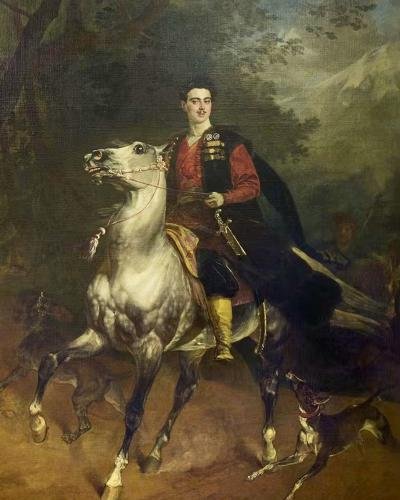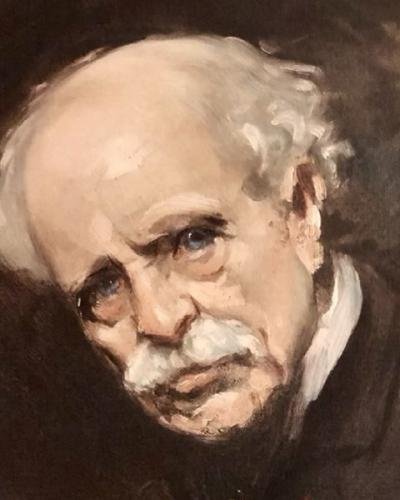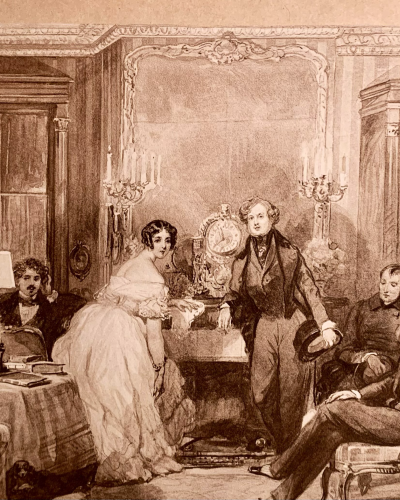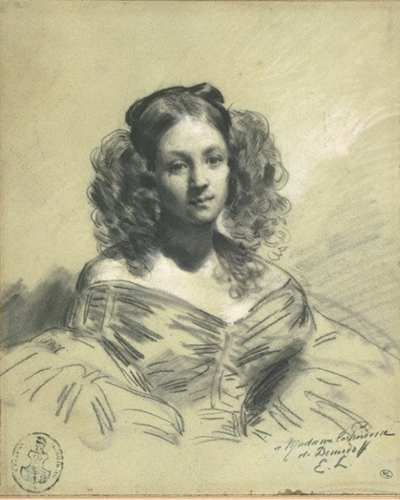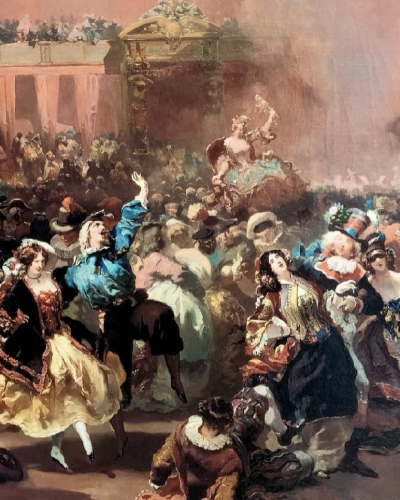Anatole Nikolaievitch Demidoff was determined to establish himself at the highest level of Parisian high-society at the start of the 1830's.Like his elder brother, Paul Nikolaievitch Demidoff (1798 - 1840), he had recently come into his share of a substantial inheritance following the passing of their wealthy father, Nicholas Nikitich Demidoff (1773-1828), a few years earlier.
To make his mark Anatole Demidoff would follow in the footsteps of his illustrious forebears by establishing important contacts in the art world. However, unlike his predecessors, Demidoff would boldly court Paris's 'up-and-coming', and often controversial, artists. The selected young artists were pushing the boundaries of the established art market so consequently selling practically nothing. Given that Demidoff in 1833 was aged only 20, the artists that he came to know were all much older. These included, amongst others, Eugene Lami, who was 33, Paul Delaroche, who was 36, and Eugene Delacroix, aged 35. The focus of this paper will be on Demidoff’s engagement with each of these three artists and starting first with a discussion on Eugene Lami.
In the earlier decade of the 1820's, these artists were forced to lead ‘bohemian’ lifestyles, attending art school together, while living in shared, squalid living accommodations in the 'Latin Quarter' of Paris.A rare benefactor was Jean-Marie-Fortuné Durand (1800-1865), who owned a stationery shop selling artists's supplies in the St. Germain de Pres district of Paris. A half-century later, his son, Paul Durand-Ruel, would become known worldwide as the 'father of the impressionists'.
Jean-Marie-Fortuné Durand had acquired a keen interest in the early 19th Century British watercolourists due to his friendship with John Lewis Brown Sr., a rich Scottish wine trader and passionate collector of art. Brown Sr. was especially fond of the watercolours of Richard Parkes Bonington (1802-1828).Following the passing of Brown Sr., Demidoff would purchase a series of watercolours by Bonington at the 1837 Brown auction that would come to form the core of his Romantic collection of paintings and that today can be viewed at the Wallace Collection in London.
Durand, impressed with the quality of the works produced by the struggling young artists agreed to take a few watercolours, together with their lithographs, in exchange for painter's supplies. These paintings depicting British history and dramatic scenes from Shakespeare’s plays would be then displayed throughout the shop. The practise of exchanging works of art for painter's supplies would be used in the early careers of such artists as Theodore Géricault, Nicolas-Toussaint Charlet, and Auguste Raffet, amongst others. In the end, this proved a wise business decision since the shop quickly became a prominent meeting place for any serious collector who was keen to view the latest trends in art as well as to meet the lively, young artists in person.
Another resource for these struggling artist was to secure admission into the studio of an already established artist. This included the studio of Horace Vernet (1789-1863), that was situated on 11 di rue des Martyrs in Montmartre. Vernet came from a distinguished line of highly regardedand established painters. One of Vernet’s important clients was Nicholas Demidoff, who collected the works of Vernet’s forebears and, in 1826, commissioned Vernet to paint a portrait of his teenage son, Anatole Demidoff, on horseback.
Horace's studio was a focal point for Bonaparte sympathisers and former officers of Napoleon's Grande Armée, who were openly hostile to the Bourbon government. Eugene Lami (1800-1890) entered the studio as a teenager and would collaborate closely with his first teacher. This included raising the illustrations for such books as 'Napoleonic French Military Uniforms’ that issued in 1822. Despite the wide difference in age, the two would become long-lasting close friends.
Vernet's practice was to send his best students to the Ecole des Beaux Arts and, in 1817, Lami was selected to study with Antoine-Jean Gros (1771-1835), the renowned painter of Napoleonic portraits. It would be at Gros’s studio that Lami would meet Paul Delaroche and Richard Parkes Bonington. And it would be from Bonington that Lami would learn the method of combining watercolour with touches of gouache and gum arabic to achieve a brilliant and bright palette.
Vernet further introduced Lami to the Orleans family given that Louis-Philippe, due d’Orleans, was one of Vernet’s leading patrons.Lami would establish an especially close bond with the children of King Louis-Philippe, whom Lami taught how to draw commencing in 1831. Once of age, both Henri d’Orléans and his brother, the Duke of Aumale, would engage Lami as their principle decorator and portraitist.
Demidoff became one of Lami's most steadfast and loyal champions commencing in 1834. From 1836 to 1840, Lami was commissioned to depict the 'Histoire de mon temps' that resulted in the production of 61 watercolours. In 1840, Lami painted ‘Le Salon de la Comtesse Somailoff’, where one can see Lami sitting on the far left with Demidoff sitting next to him.In the centre, the Comtesse Somailoff (1838-1896) is shown standing next to Count Charles de Mornay (1803-1878), the leading French foreign diplomat under the reign of Louis-Philippe, the King of the French.On the right, sitting next to the Count is Paul Delaroche.
Another delicate drawing by Lami was made of Princess Mathilde Bonaparte Demidoff who had recently married Demidoff in November, 1840 in Florence. In late 1840, Princess Mathilde arrived in Paris, for the first time, specifically to witness the funeral procession of her uncle, the Emperor, that took place under harsh winter conditions on 15 December 1840. It was Demidoff, due to his persistence, combined with his close personal friendship with the Count de Mornay, who had secured the French government's approval to allow the Bonaparte family members to return to France following two decades of exile abroad.
Following the revolution of 1848, Lami joined Louis-Philippe in exile in England under the protection of Queen Victoria. It also would be in 1850 that Demidoff would purchase from Vernet, ‘Cholera et Socialisme’, a highly controversial painting that caustically expressed displeasure with the political outcome of the 1848 revolution.
Soon thereafter, on the 1st of May1851, Prince Albert's, 'Great Exhibition' opened in London to record attendance and long-lasting fame. Lami received from Queen Victoria a commission for a watercolour of the 'Opening of the Great Exhibition' that today can be seen at Buckingham Palace. Lami also received a commission from Demidoff to raise a series of nine watercolours depicting various views of this landmark event to be gifted to Empress Alexandra Fyodorovna, the wife of Tsar Nicholas I.Demidoff was so taken with Lami’s results that another commission issued to Lami for a duplicate set of watercolours for display at Demidoff’s Villa di San Donato located near Florence.The attached image shows Demidoff’s, 'Inauguration of Crystal Palace’ as well as Queen Victoria’s, ‘Opening of the Great Exhibition’.
Amongst the many other works of art that Lami would be requested by Demidoff to paint would be the energetic, 'Grand Bal Masqué de l'Opéra', that dates to 1854. This oil painting would subsequently enter the collection of the Marquess of Hertford at this residence in Bagatelle in Paris.
In the end, Demidoff unquestionably became one of Lami’s principle patrons, joining the members of the Orleans family and the Rothschilds, together with other informed collectors, who considered Lami amongst the leading watercolourists of his age.
